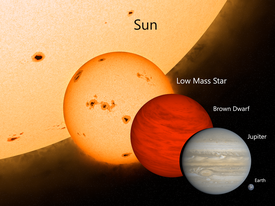
Back Bruindwerg Afrikaans Nana parda AN قزم بني Arabic Nana marrón AST Карычневы карлік Byelorussian Кафяво джудже Bulgarian Smeđi patuljak BS Nana marró Catalan Hnědý trpaslík Czech Хăмăр карлик CV
Brown dwarfs are substellar objects that have more mass than the biggest gas giant planets, but less than the least massive main-sequence stars. Their mass is approximately 13 to 80 times that of Jupiter (MJ)[2][3]—not big enough to sustain nuclear fusion of ordinary hydrogen (1H) into helium in their cores, but massive enough to emit some light and heat from the fusion of deuterium (2H). The most massive ones (> 65 MJ) can fuse lithium (7Li).[3]
Astronomers classify self-luminous objects by spectral type, a distinction intimately tied to the surface temperature, and brown dwarfs occupy types M, L, T, and Y.[4][5] As brown dwarfs do not undergo stable hydrogen fusion, they cool down over time, progressively passing through later spectral types as they age.
Their name comes not from the color of light they emit but from their falling between white dwarf stars and "dark" planets in size. To the naked eye, brown dwarfs would appear in different colors depending on their temperature.[4] The warmest ones are possibly orange or red,[6] while cooler brown dwarfs would likely appear magenta or black to the human eye.[4][7] Brown dwarfs may be fully convective, with no layers or chemical differentiation by depth.[8]
Though their existence was initially theorized in the 1960s, it was not until the mid-1990s that the first unambiguous brown dwarfs were discovered. As brown dwarfs have relatively low surface temperatures, they are not very bright at visible wavelengths, emitting most of their light in the infrared. However, with the advent of more capable infrared detecting devices, thousands of brown dwarfs have been identified. The nearest known brown dwarfs are located in the Luhman 16 system, a binary of L- and T-type brown dwarfs about 6.5 light-years (2.0 parsecs) from the Sun. Luhman 16 is the third closest system to the Sun after Alpha Centauri and Barnard's Star.
- ^ Sorahana, Satoko; Yamamura, Issei; Murakami, Hiroshi (2013). "On the Radii of Brown Dwarfs Measured with AKARI Near-infrared Spectroscopy". The Astrophysical Journal. 767 (1): 77. arXiv:1304.1259. Bibcode:2013ApJ...767...77S. doi:10.1088/0004-637X/767/1/77.
We find that the brown dwarf radius ranges between 0.64–1.13 RJ with an average radius of 0.83 RJ.
- ^ Boss, Alan; McDowell, Tina (April 3, 2001). "Are They Planets or What?". Untitled Document. Carnegie Institution of Washington. Archived from the original on September 28, 2006. Retrieved March 31, 2022.
- ^ a b Wethington, Nicholos (October 6, 2008). "Dense Exoplanet Creates Classification Calamity". Universe Today. Retrieved March 31, 2022.
- ^ a b c Cite error: The named reference
PT-June2008was invoked but never defined (see the help page). - ^ Springer, Cham (2014). Joergens, Viki (ed.). 50 Years of Brown Dwarfs. Astrophysics and Space Science Library. Vol. 401. SpringerLink. XI, 168. doi:10.1007/978-3-319-01162-2. eISSN 2214-7985. ISBN 978-3-319-01162-2. ISSN 0067-0057. Retrieved March 31, 2022.
- ^ Cain, Fraser (January 6, 2009). "If Brown Isn't a Color, What Color are Brown Dwarfs?". Retrieved 24 September 2013.
- ^ Burrows, Adam; Hubbard, William B.; Lunine, Jonathan I.; Liebert, James (2001). "The Theory of Brown Dwarfs and Extrasolar Giant Planets". Reviews of Modern Physics. 73 (3): 719–765. arXiv:astro-ph/0103383. Bibcode:2001RvMP...73..719B. doi:10.1103/RevModPhys.73.719. S2CID 204927572.
- ^ O'Neill, Ian (13 September 2011). "Violent Storms Rage on Nearby Brown Dwarf". Seeker.com.

